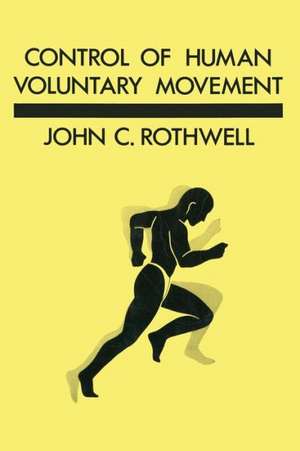Control of Human Voluntary Movement
Autor J.C. Rothwellen Limba Engleză Paperback – 19 apr 2012
Preț: 644.37 lei
Preț vechi: 758.09 lei
-15% Nou
Puncte Express: 967
Preț estimativ în valută:
123.33€ • 127.10$ • 104.12£
123.33€ • 127.10$ • 104.12£
Carte tipărită la comandă
Livrare economică 03-17 martie
Preluare comenzi: 021 569.72.76
Specificații
ISBN-13: 9781468476903
ISBN-10: 1468476904
Pagini: 344
Ilustrații: XVI, 326 p.
Dimensiuni: 155 x 235 x 25 mm
Greutate: 0.53 kg
Ediția:Softcover reprint of the original 1st ed. 1987
Editura: Springer Us
Colecția Springer
Locul publicării:New York, NY, United States
ISBN-10: 1468476904
Pagini: 344
Ilustrații: XVI, 326 p.
Dimensiuni: 155 x 235 x 25 mm
Greutate: 0.53 kg
Ediția:Softcover reprint of the original 1st ed. 1987
Editura: Springer Us
Colecția Springer
Locul publicării:New York, NY, United States
Public țintă
ResearchCuprins
1. Introduction. Plans, Strategies and Actions.- Categories of Muscles.- Problems of Moving.- A Legacy.- 2. Mechanical Properties of Muscles.- Review of Muscle Anatomy.- Mechanical Properties of Muscle.- Behaviour of Isolated Muscle Stimulated at Subtetanic Rates.- Muscle Mechanics in Intact Man.- Effects of Muscle Properties on Control of Movement.- A Theory of Movement Control which Makes Use of the Mechanical Properties of Muscle.- 3. The Motor Unit.- The Concept of the Motor Unit.- Twitch and Tonic Muscle Fibres.- Physiological Investigation of the Motor Unit.- Histochemical and Biochemical Classification of Muscle Fibres.- Some Electrophysiological Properties of Motoneurones.- Control of Motor Units and their Recruitment Order.- The Study of Motor Units in Human Physiology.- Pathophysiology of the Motor Unit.- 4. Proprioceptors in Muscle, Joint and Skin.- Muscle Receptors: I. The Muscle Spindle.- Muscle Receptors: II. Golgi Tendon Organs.- Muscle Receptors: III. Other Types of Ending.- Joint Receptors.- Cutaneous Mechanoreceptors.- Recordings from Human Afferent Nerve Fibres.- 5. Reflex Pathways in the Spinal Cord.- Classification of Nerve Fibres.- Reflex Pathways from la Muscle Spindle Afferents.- Reflex Pathways from lb Tendon Organ Afferents.- Reflex Pathways from Group II Muscle Afferents and the ‘Flexor Reflex Afferents’.- The Renshaw Cell.- Integration in Spinal Reflex Pathways.- Presynaptic Inhibition.- 6. Functional Consequences of Activity in Spinal Reflex Pathways.- The Stretch Reflex in Animals.- Stretch Reflexes in Human Muscles.- The Servo Hypothesis and Alpha-Gamma Coactivation.- The Regulation of Stiffness Hypothesis and lb Effects.- Other Spinal Reflex Pathways.- Cutaneous Reflexes.- Pathophysiology of the Stretch Reflex: Disorders of MuscleTone.- Pathophysiology of Other Reflex Pathways.- 7. Ascending and Descending Pathways of the Spinal Cord.- Ascending Pathways.- 8. Cerebral Cortex.- Structure of Cerebral Cortex.- Detailed Electrophysiology of Primary Motor (MI) Cortex.- The Pyramidal Tract.- Motor Cortex Cell Activity During Voluntary Movements.- Sensory Input to Motor Cortex.- Other Motor Areas of Cortex.- Supplementary Motor Area.- Motor Functions of Parietal Cortex.- Pathophysiology of Motor Areas of Cerebral Cortex.- 9. The Cerebellum.- Cerebellar Anatomy.- Electrophysiological Studies of the Cerebellum.- Effects of Cerebellar Lesions.- Studies of Cerebellar Dysfunction in Man.- Theories of Cerebellar Function.- 10. The Basal Ganglia.- Anatomy.- Electrophysiological Recordings from Behaving Animals.- Pathophysiology of Diseases of the Basal Ganglia in Man.

